
If you want to send emails that get opened, you need to consider email automation. Why? Automated emails have higher open and click-through rates than routine emails.
Currently, around 50% of businesses use email automation software to send email drip campaigns. If you’re not doing the same, you’re missing out on a powerful opportunity to attract and retain customers.
If you’re already using email marketing to connect with potential and existing customers, you’re halfway there. However, if you want to drive even more revenue through email, automation is key, as 75% of email revenue is generated from triggered campaigns.
In this article, we’ll share how you can use email automation to nurture your prospects and drive conversions. We’ll also share some examples of email automation for you to try out yourself.
What Is Email Automation?
Email automation automatically sends emails to your subscribers based on triggers.
Rather than manually sending out individual emails, automated email workflows handle the entire process for you.
Using email automation tools, you can set specific triggers that initiate the sending of an email. Triggers can be:
- Time-based: A date or time, like a customer’s birthday.
- Action-based: When a customer signs up for your newsletter, makes a purchase, or clicks a link., for example.
- Behavior-baed: When a user visits a particular page on your website or interacts with your site in certain ways.
You’ll then need to develop email templates that can be customized with customer data before they’re sent.
Next, you can create email automation workflows that send a sequence of emails based on timing or actions. For example, if a prospect doesn’t open your first email, you might set it as a trigger for an automatic follow-up email.
On the other hand, a subscriber opening an email or clicking a link might trigger an email sequence that delivers content based on what they’ve received in your first email.

Automated emails have proven to be a cost-effective way to:
- Build great relationships with customers.
- Keep your subscribers engaged.
- Boost conversion rates.
- Improve customer experience.
The Benefits of Email Automation
Using email marketing automation tools can bring significant advantages to your marketing strategy, including:
➡️ Efficiency
Email automation handles repetitive and manual tasks, saving marketing teams a lot of time. This means they can focus their efforts on tasks that have a bigger impact on your business, like strategy.
➡️ Scalability
Automation can manage growing email lists without extra work. Even if your business scales yo, you won’t need to hire extra employees to handle your email marketing. Your automation tool can tackle larger amounts of work for you.
➡️ Opportunities for personalization
Automation tools can segment audiences for targeted messaging. This means you can send different content to different groups of subscribers rather than sending mass messages that may not be relevant to large parts of your audience.
➡️ Consistency
Automated emails are sent regularly and at optimal times. This means you can communicate with your subscribers often enough to keep them engaged and reach them at the right time.
➡️ Engagement
Timely, relevant emails foster better user engagement. Rather than sending sporadic emails when you have time to do them yourself manually, automation handles this for you.
➡️ Analytics
Email automation tools typically provide useful metrics to improve strategies.
For example, if you see a large portion of your audience isn’t opening your welcome emails, you know you need to adjust the content of these messages to achieve a better open rate.
➡️ Customer retention
Automation helps build stronger relationships and retain more customers. Retaining existing customers is significantly cheaper than acquiring new ones.
➡️ Revenue
With better efficiency and engagement, email automation may help to boost your sales. This makes any money you’ve spent on investing in email automation worthwhile.

Email Automation Examples to Help You Get Started
Now that you understand how email automation works and how it can benefit your business let’s look at a few examples of automated campaigns to help inspire you:
Welcome emails
Did you know that 74% of users expect welcome emails post sign-up? As of 2024, welcome emails have an impressive average open rate of 86%.
It’s clear that a welcome email is more than a polite nod—it’s an opportunity to engage new subscribers who’ve just expressed their interest in what you offer.
Email automation can help you take advantage of this chance to make a good first impression. When someone signs up for your email database, an automated email can be sent to them, thanking them for subscribing.
A good welcome email should be thoughtfully structured and generally include the following elements:
✔️ A warm greeting
Begin the email with a friendly hello. A welcome email is the perfect opportunity to inform your subscribers what to expect from you and highlight the value your product or service will bring them.
✔️ Showcase your brand’s personality
Encourage subscribers to engage with your brand by following your social media accounts, subscribing to your blog, downloading a resource, or exploring a product feature.
✔️ Clear instructions
If applicable, give the recipient instructions on what to do next, whether setting up their profile, getting started with your product, or taking advantage of a new customer offer.
✔️ An incentive
To express gratitude to new subscribers or customers, offer them an incentive, like a discount coupon. This can motivate them to make their first purchase, which is ideal for eCommerce businesses.
✔️ Support and feedback
Provide clear contact information and links to resources such as frequently asked questions (FAQs) and user support.
Encourage feedback to understand their experience and improve your marketing automation strategy.
| 🚀 Pro Tip: Use Welcome Email Templates Take your time and create a welcome email that grasps your subscribers’ attention and encourages engagement. Branding is essential to getting this right. If you are not a designer, take advantage of these welcome email templates, which will make your life a lot easier. |
An example
One of our favorite automated email examples is from a company called Away, a luxury luggage company.

Even before new customers open their email, the brand welcomes them warmly via a clever subject line—”We’re away. Let’s meet up.” This clever wordplay sets a good tone right from the start.
Next, the brand swiftly takes the opportunity to introduce itself. They also clearly show how their product will improve the reader’s life, followed by a gentle nudge to learn more about the company and delve deeper into its offerings.
The narrative then unfolds to spotlight their product’s key features, enhancing the reader’s understanding and generating interest.
They then include an enticing incentive. They present an offer of a 100-day trial, which is available with any luggage purchase.
This strategic incentive may drive the subscriber to make their first purchase and instill confidence in the product. Both factors make the email successful in engaging the new customer.
2. Onboarding campaigns
Of all the different types of automated workflows, onboarding may be one of the most important, particularly if you offer a SaaS-type service.
The purpose of an onboarding email is to welcome new users when they sign up for paid subscriptions or digital products.
Its main purpose is to guide the user in quickly understanding your offering and gaining value from the product or service.
Once a customer has signed up for your product or service, this could trigger a sequence of automated emails that gradually introduce your brand and serve them the information they need to get started.
An effective user onboarding email sequence should include the following:
✔️ Welcome and confirmation
Start by warmly welcoming the user and confirming their successful signup. This immediately reassures them that the process was completed correctly.
✔️ Introduction to your product or service
Give a brief overview of what your product or service does and its benefits. This should be done in simple, plain language to avoid overwhelming the user.
✔️ How to get started
Provide a clear, step-by-step guide on using your product or service. You might include links to a tutorial, a user guide, or a video demonstration.
✔️ Resources for help
Provide resources where users can seek assistance if they encounter problems or have questions. This could include links to FAQs, a help center, or customer support contact information.
✔️ Quick wins
Encourage users to explore and engage with the product by completing an easy task for them to achieve. This could also be done by highlighting key features, offering tips and tricks, and social proof.
✔️ Clear call to action (CTA)
Always include a clear CTA that guides users on their next steps. This might be to start a tutorial, set up their profile, or use a particular feature.
An example
Framer is a low-code prototyping platform. This onboarding email is a great example of an email automation workflow done right:
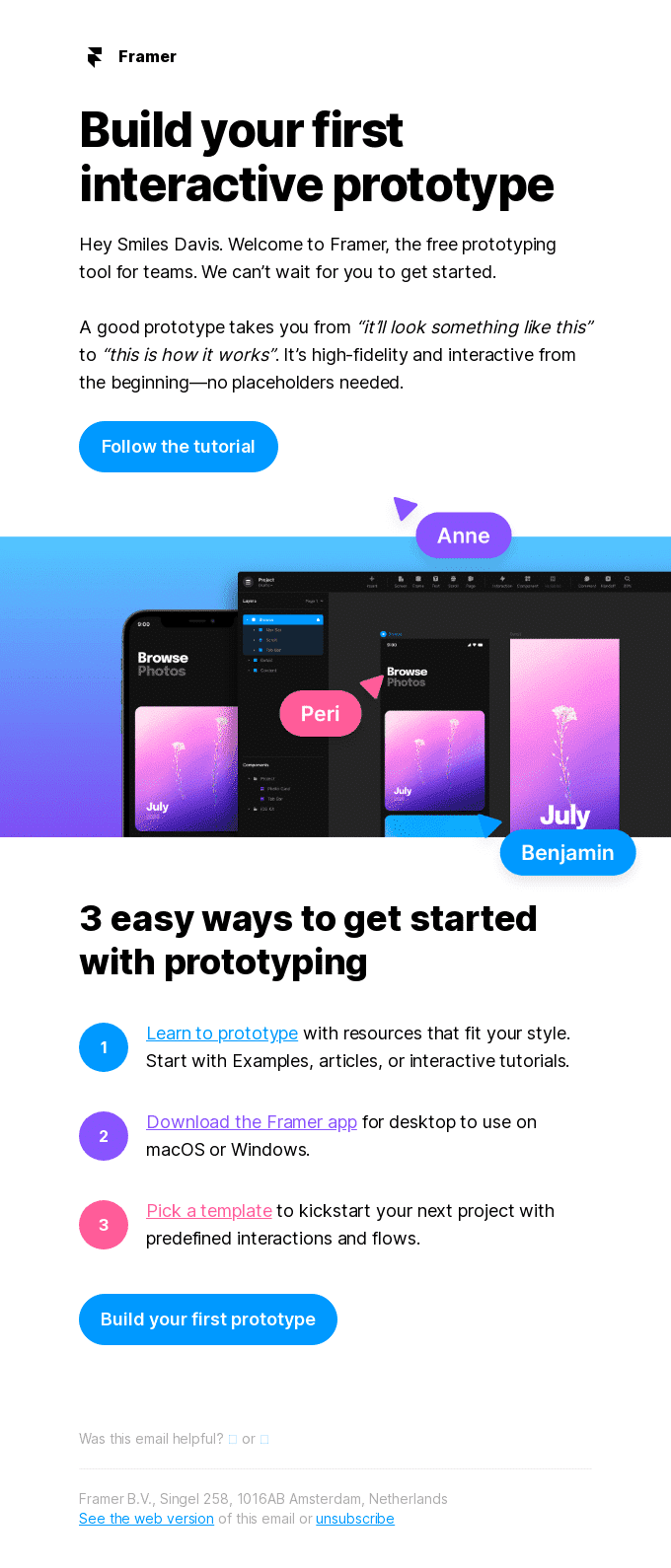
Here’s why this onboarding example works so well:
💡 Quick win introduction: By promising users that they will learn how to create their prototype, Framer’s email immediately offers tangible value. This engages users right from the start and motivates them to continue reading.
💡 Strong welcome: The warm welcome from Framer helps establish a friendly and approachable tone for future communications, which may contribute to positive brand perception.
💡 Clear call to action (CTA): The “follow this tutorial” CTA offers a straightforward next step for users to start with Framer. This helps reduce uncertainty, which can lead to higher engagement rates.
💡 Guidance toward the ‘Aha! moment’: Providing additional resources and a quick win opportunity (like using a template) is a great strategy to guide users toward their “Aha! moment”—in this case, the moment they realize the value of Framer’s platform. This approach can significantly enhance user understanding, engagement, and satisfaction with the product.
💡 Onboarding and user retention: By effectively guiding new users through the platform’s initial stages, Framer will likely increase user retention and build customer relationships.
When it comes to onboarding emails, don’t place too much emphasis on flashy designs. Sometimes, well-crafted, hyper-personalized text can do the trick. Just look at how Groove gets it right with its text-centric onboarding email approach:

3. Cross-sell and upsell emails
In order to grow your business, you need to make more sales. In this email automation example, we’ll look at how marketers use cross-sell upsell emails to increase the revenue of their brand.
It’s crucial to keep interacting with existing customers after they’ve made a purchase, especially when your brand offers a variety of products or services. That’s precisely where cross-selling and upselling strategies can be super useful:
➡️ Upselling: This involves encouraging a customer to buy a more expensive version of an item or to add features or services that can increase the value of their initial purchase. For instance, upselling a customer from a basic software package to a premium package.
➡️ Cross-selling: This refers to the strategy of selling different products or services to an existing customer that are complementary to the ones they’ve already purchased. For example, if a customer has bought a laptop, a cross-sell email might recommend a laptop bag or a mouse.
The general strategy for marketing automation emails works as follows:
1️⃣ Send an email to your customers that features the product they’ve bought.
2️⃣ Follow up with another email to suggest new products or services that match their purchase.
This strategy is a great way to continue the conversation and potentially generate more sales.
Good cross-sell or upsell marketing emails should include the following:
✔️ Personalization
Leverage customer data to offer personalized recommendations. Reference previous shopping history and customize your special offers accordingly.
✔️ A value proposition
Clearly explain the benefits of the additional or higher-value product. Show how it complements their initial purchase, provides better features, or adds value.
✔️ A strong call to action (CTA)
To drive the customer to consider the recommended product or upgraded service, your CTA should be clear and compelling.
✔️ Visual appeal
High-quality images and good design can help make your products more attractive and appealing to customers.
✔️ Social proof
Reviews, testimonials, or ratings can help persuade customers of the value or popularity of the recommended product.
✔️ Limited-time offer
Offering a discount on the additional product or upgraded service for a limited time can create a sense of urgency and encourage immediate action.
An example
Kickresume has had great results with email automation. Typically, subscribers will receive a lead nurturing email shortly after signing up for an account with them, and once they’ve started using it:
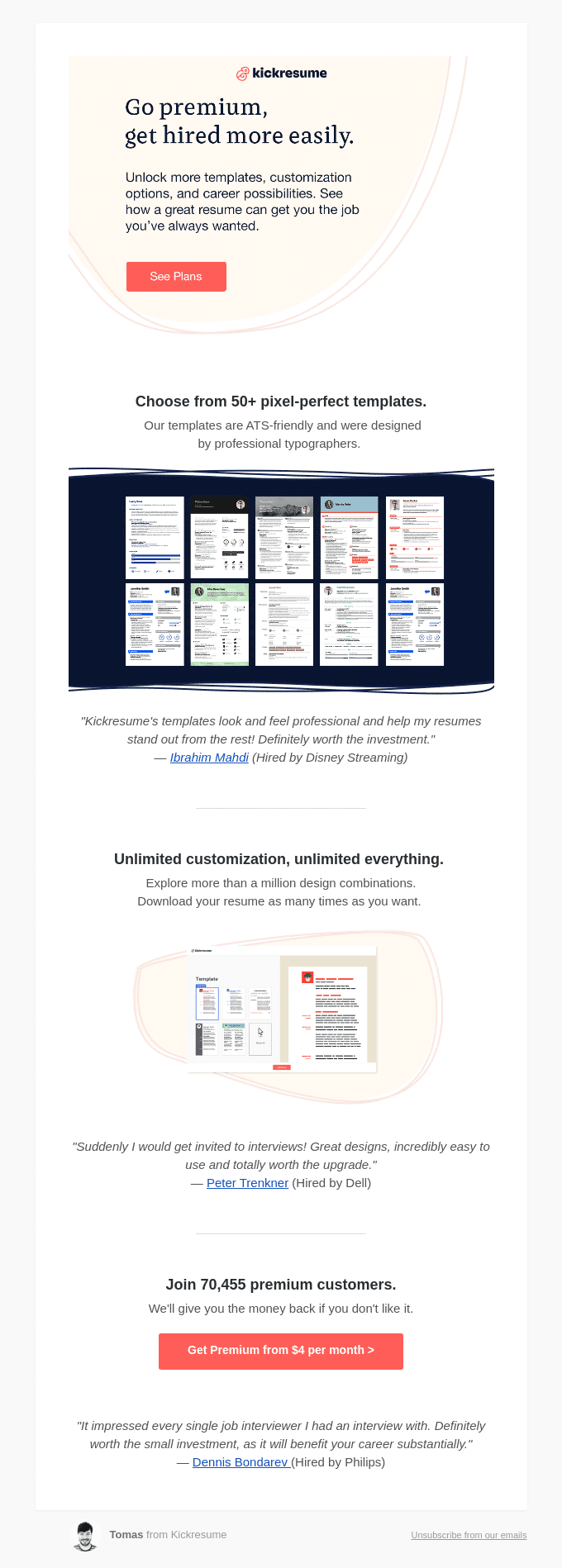
Immediately, the customer is presented with a compelling value proposition—by going premium, they’ll be on the fast track to securing a job. This proposition is closely followed by a clear CTA directing them to explore pricing plans.
Their email also has great visual appeal, which captivates the reader. It articulates the benefits the customer will gain when upgrading to a premium subscription.
It also leverages social proof by showcasing a customer testimonial and highlighting the sizable number of premium subscribers, which bolsters the trust factor.
It also comes with a customer-friendly promise—a money-back guarantee—which assures customers of a risk-free investment:
| 🚀 Pro Tip: Offer a Discount on Their Next Purchase Addressing customer pain points in subsequent emails can deepen engagement. Throw in a discount code for their next purchase, and you’ve got a winning strategy that resolves issues and offers a financial incentive to upgrade. |
4. Lead magnets
Lead magnets are an essential feature of a lead-generating funnel that converts well and promotes customer loyalty.
| 💡 What Is a Lead Magnet? A lead magnet is an incentive marketers use to offer potential buyers in exchange for their email addresses or other contact information. Lead magnets usually offer digital, downloadable content, such as a free PDF checklist, report, e-book, whitepaper, or video series. The goal of a lead magnet is to maximize the number of leads you are targeting for an offer by providing value to the potential customer. The idea is to provide so much value for free that the potential customer will be more open to future communications from your business, which paves the way for potential sales. |
Simply collecting email addresses and sending a download link for your lead magnets in a single email isn’t enough. Instead, consider setting up a tailored email automation workflow for each lead magnet.
This allows you to provide additional information, engage your subscribers more deeply, and foster meaningful interaction with your brand.
An example
Here is an automated email workflow you can create to be triggered when someone downloads your lead magnet:
🔸 Acquisition
This is where your potential customer first encounters the lead magnet. It could be a blog post with a content upgrade, a pop-up on your website, a social media post, or an online ad.
Here’s an example from a wellness company called Solluna of a lead magnet where users provide their personal information in order to download the results of a quiz:
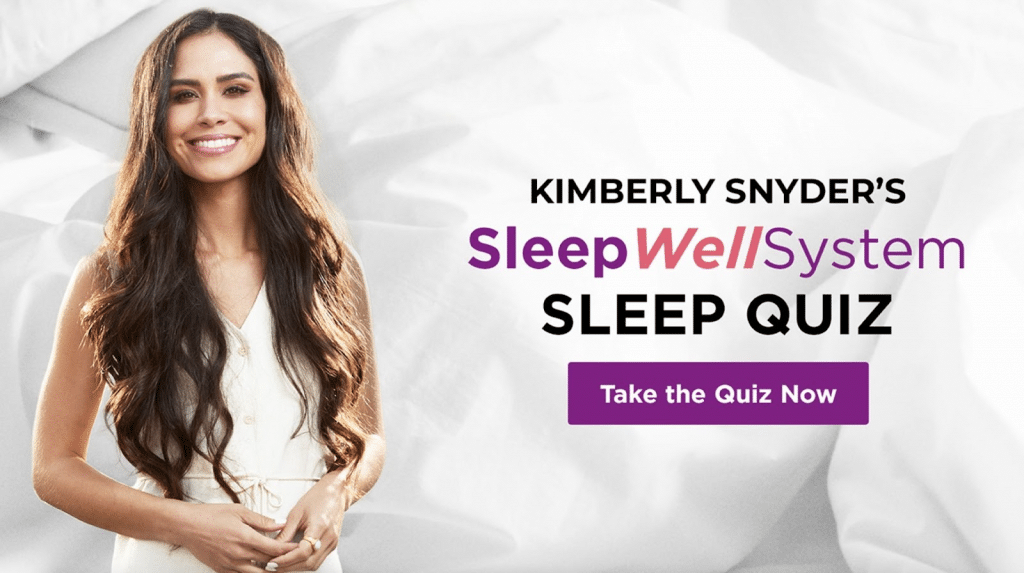
🔸 Sign-up
The potential customer clicks on the lead magnet and is taken to a landing page or a sign-up form where they enter their email address (and possibly other information) to receive your lead magnet.
In this example, you can see that software company Algolia displays a pop-up form on their website when users want to download a report:
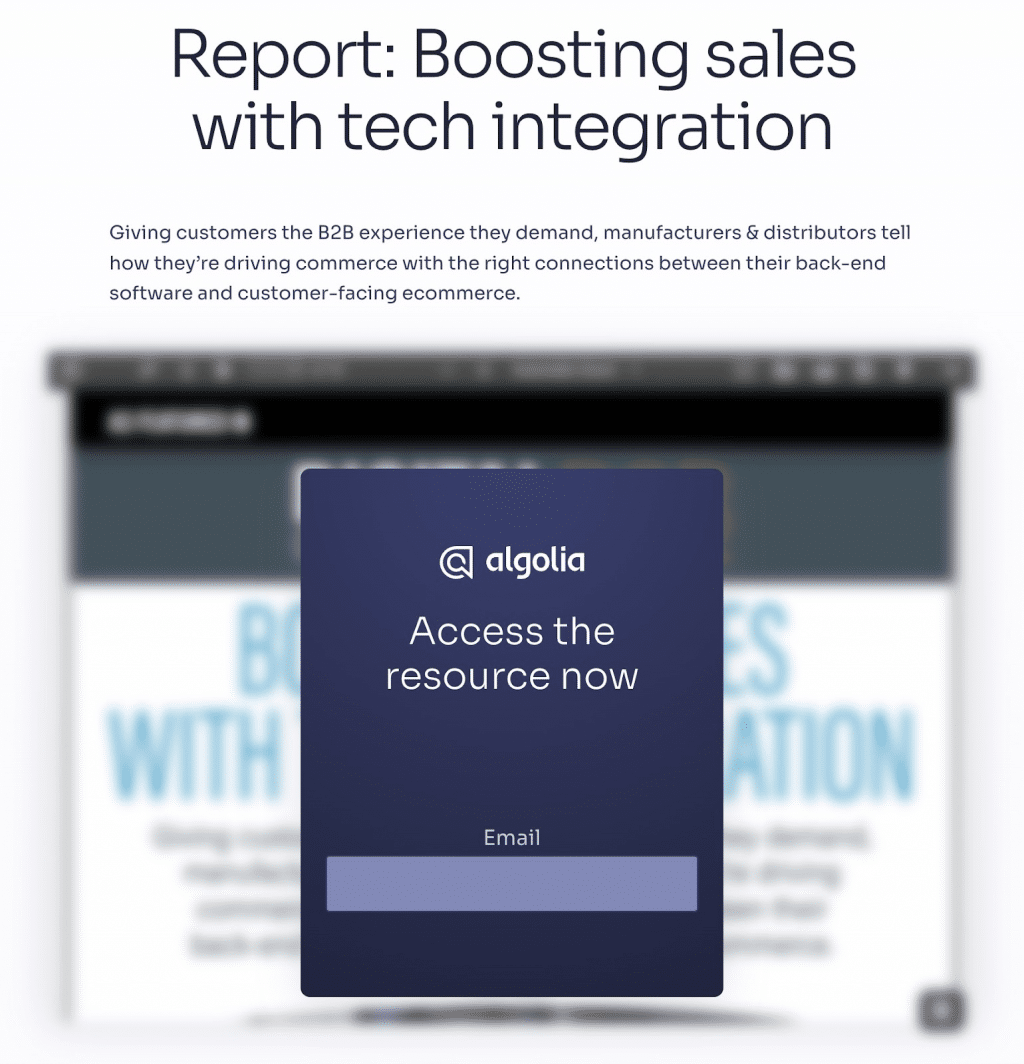
🔸 Welcome and delivery email
The first in a series of automated emails will include a welcome message. This is the first email your new subscriber receives after signing up for your lead magnet.
It should thank them for their interest, deliver the details and a link for the lead magnet, and briefly explain what they can expect from your future emails.
Here’s an example from OptinMonster of the automated email that subscribers receive after signing up to download an e-book:
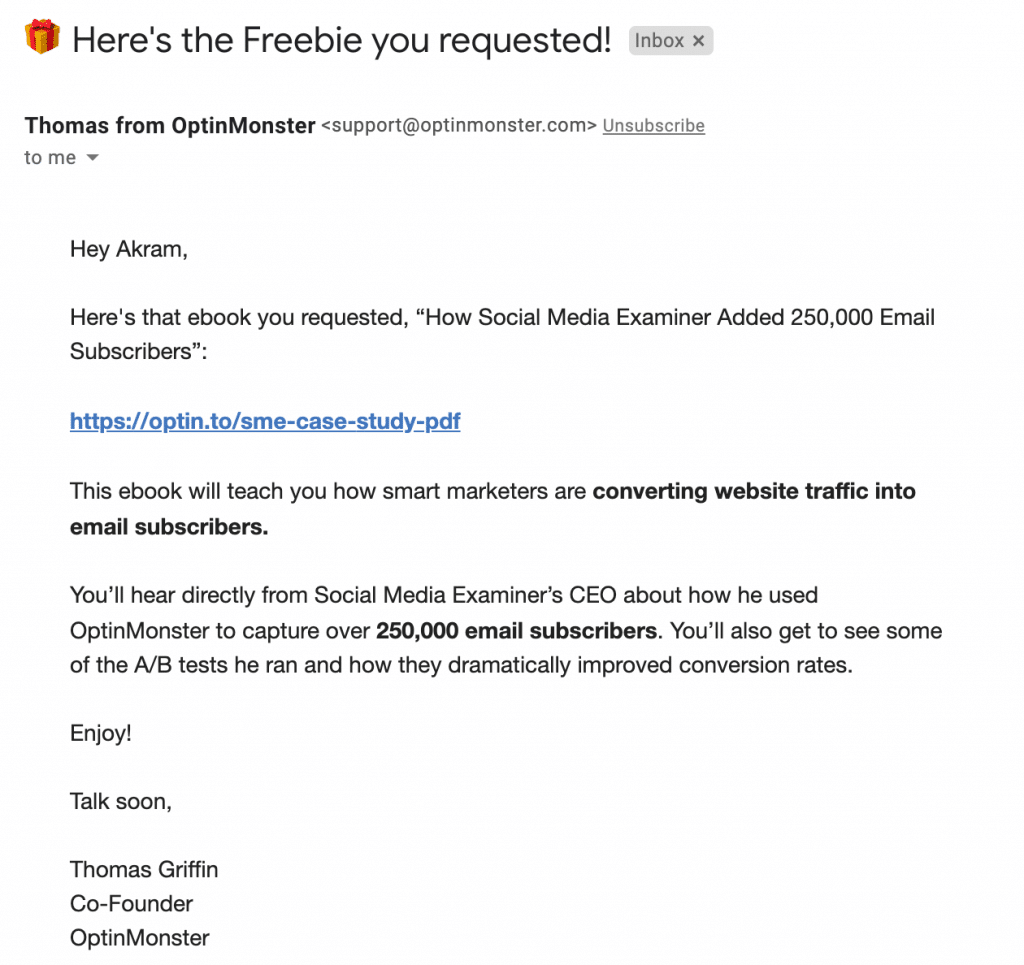
🔸 Check-in email
After a day or two, send a check-in email. Ask whether they’ve found the lead magnet useful and whether they have any questions about it. This provides value and shows that you care about their experience.
🔸 Additional value email
A few days later, send an email that offers additional, related value.
This may include relevant blog posts, infographics, or podcasts related to the content your subscriber downloaded. Include some teaser sentences, a call to action, and a link to your email content.
The idea is to continue providing value and to start positioning your business as a trusted authority in your industry.
🔸 Soft pitch email
A series of follow-up emails are sent over the next few days or weeks. After providing additional value, you can start introducing your product or service softly.
Share a success story, case study, or testimonial that shows your product or service in action. It’s not a hard sell, just a gentle introduction. Make sure you’re progressively building up to your sales pitch.
🔸 Hard pitch email
Now that you’ve provided lots of value and built some rapport, it’s time for a stronger pitch.
Explain how your product or service can help your prospects, what makes it unique, and why they should consider purchasing it. Be sure to include a clear call to action in this email.
🔸 Last-chance email
Send a last-chance email if the recipient hasn’t responded to your previous pitch. Remind them of the benefits of your product or service, and consider offering them a limited-time discount or bonus to create urgency.
| 🚀 Pro-Tip: Consider Your Sequences Pay attention to the sequencing of your emails when you design your automation campaign. Each email is a micro funnel, and effective sequencing and targeted content are key to moving leads down the funnel toward conversion. |
🔸 Non-responder follow-up
If the recipient still hasn’t responded, put them into a different email sequence or category. You might send occasional check-in emails, share more content, or offer other lead magnets in the future.
| 💡 How Many Emails Are Too Many? There’s no clear-cut amount of emails that you should include in a sequence like the one following a lead magnet. Our advice is to send between three and five emails. It’s important to track and analyze your results. See which emails get the most opens, clicks, and conversions, and continually refine your sequence based on this data. |
5. Customer satisfaction emails
In today’s world, almost every company has a customer success team. They assist your customers, respond to their inquiries and problems, and manage feedback or complaints.
Beyond just support, this function can significantly bolster sales and enhance customer satisfaction.
But where does email marketing automation fit into this picture? Your sales or marketing team can use this tactic in several ways to craft a distinct experience for your customers.
For instance, brands can use automated ‘thank you’ emails to gather reviews and feedback.
Or, you can send out surveys to collect invaluable customer insights. The examples below will show you how useful it is to automate repetitive marketing tasks like surveys and feedback.
Some examples
Here are two examples of emails that help collect customer feedback:
Ritual
When a customer care case is closed, Ritual sends a triggered email to the customer, requesting them to complete a survey to rate the quality of the assistance they received:
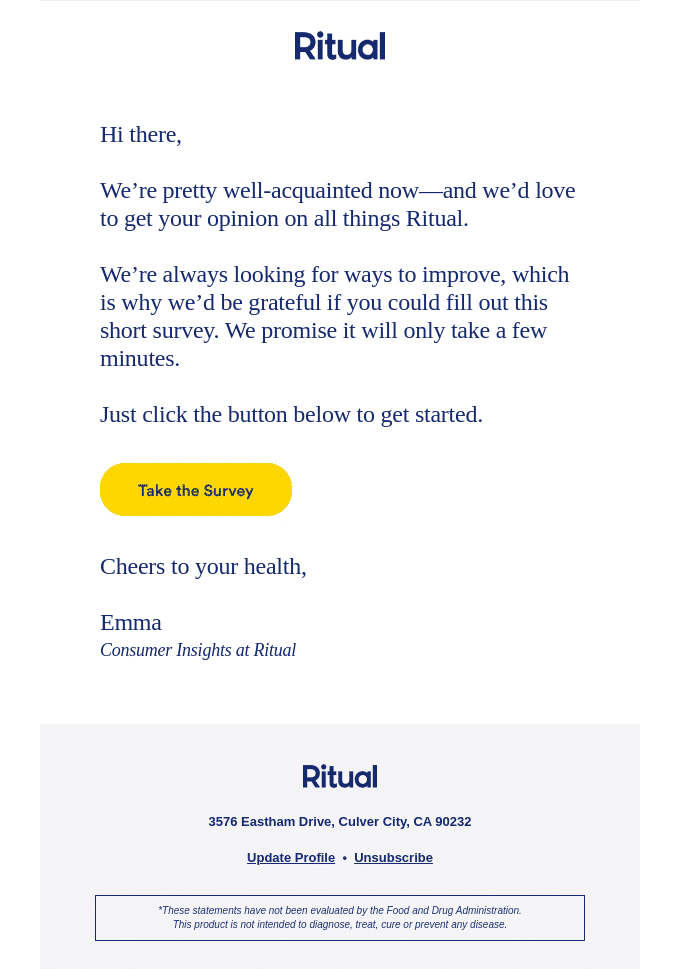
This type of email shows that you care about your customers and the level of service you deliver. It may also help you retain more customers as you’re improving their experience with your brand beyond the sale.

Dropbox follows the same strategy as Ritual, but instead of a survey, they send a review email that asks customers to rate the success of their customer support.
If a customer takes your survey or you want to show that you value your customers’ feedback, you can send a thank you email in response to their action.
Providing personalized customer service is a great way to make customers remember your brand.
6. Re-engagement emails
Subscribers may initially join your email list eager to benefit from the value you promise. Over time, this excitement can dwindle along with their engagement.
Open rates decrease, and clicks become scarce. Some subscribers may not align with your brand, but many can be re-engaged.
A re-engagement email automation campaign helps you sift through your list to retain the engaged, reinspire interest, and identify the least engaged.
A win-back or re-engagement email should ideally include the following elements:
✔️ Personalization
Use the recipient’s name or previous purchase data to tailor the message and make it more relevant.
✔️ A strong subject line
Create an engaging and intriguing subject line to increase the chances of your email being opened.
✔️ A valuable offer
Provide compelling offers such as discounts, free shipping, or exclusive access to new products. The goal is to incentivize the customer to interact with your brand again.
✔️ A CTA
Your CTA should guide customers on what to do next, whether it’s to “Shop Now,” “Reactivate Account,” or “View New Collection.”
✔️ Clear benefits
Remind the customer why they chose to interact with your brand in the first place. Highlight the unique selling propositions (USPs) of your product or service.
An example
Busuu is a platform that helps users learn new languages. Their re-engagement email is simple but effective.

Busuu uses strategic personalization in its win-back emails that specifically target customers who discontinued their subscriptions midway through a language course.
By offering an impressive 50% discount paired with a 24-hour window of opportunity, Busuu generates a compelling sense of urgency.
This encourages customers to return and take advantage of substantial savings and re-engages them with their language learning journey.
The brand has kept its email simple and short, which is often all that’s needed to re-engage a subscriber. They’ve made the discount clear immediately and included a call to action that makes it easy for their users to take action after receiving the email.
Add Personalization to Your Email Automation for Ultimate Success
And there it is—your roundup of the most essential email automation examples to supercharge your email marketing efforts in 2024. With these examples, you’re set to create automated email campaigns that save time, boost conversion rates, and elevate customer experience.
One of the biggest benefits of using email automation is that it allows you to personalize your emails at scale. Personalization is a powerful tactic to hook your subscribers from the very first email—and keep them engaged throughout your automated sequence.
With Hyperise, you can make your automated emails more than just messages, you can make them memorable. With personalized images, GIFs, CTAs, and more, our toolkit works perfectly alongside email automation.
Give the Hyperise toolkit a try with a free trial to see how personalization is the perfect way to elevate your automated email campaigns.

Alex is a content writer at Moosend. He leaped with faith into the digital marketing world from an architecture background and has never looked back. You will find him traveling in places around the world in his free time.